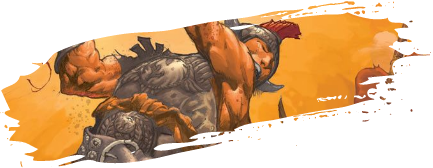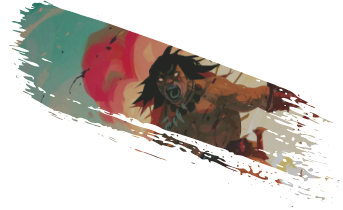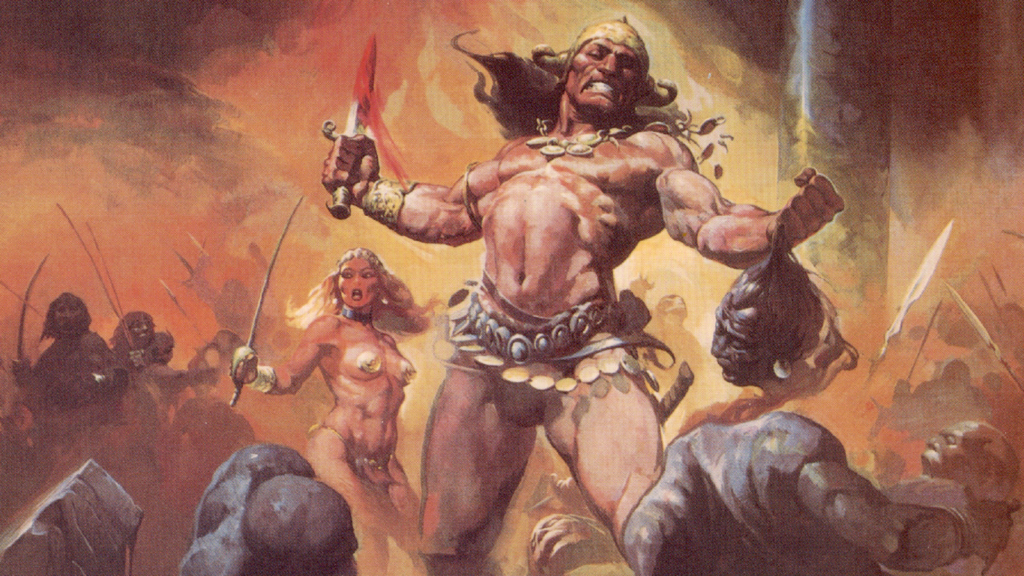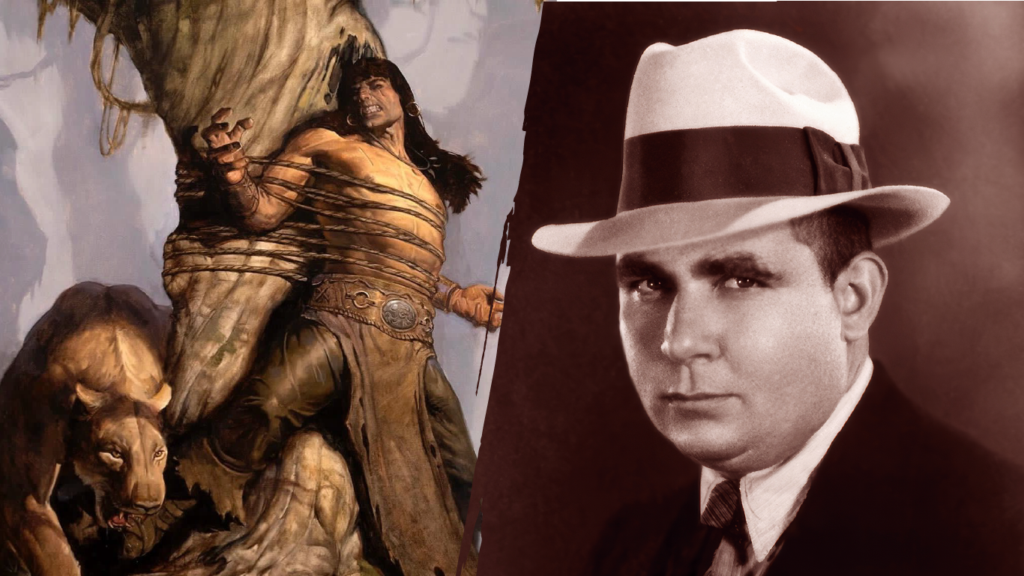
“Know, O prince, that between the years when the oceans drank Atlantis and the gleaming cities, and the years of the rise of the sons of Aryas, there was an Age undreamed of…”
The Phoenix on the Sword, Robert E. Howard
Robert E. Howard loved history, and he was particularly fascinated by its broad brush-strokes – the spread of peoples, the rise and fall of civilisations, the epic conflicts that marked epochs. His own Celtic heritage intrigued him, and in his stories he turned time and again to the north and west of the British Isles for inspiration.
Life as a writer for the pulps came with certain strictures, however. The only way to survive was to be prolific. In his short time, Howard turned out an incredible amount of work. But this meant that he had very little time to research the details of any given story. Rather than trample all over the real past, he set his series in meticulous histories of his own devising. He drew heavily on real myth and legend for these lost ages however, populating the world with states and regions carefully named to suggest aspects of reality.
These detailed timelines were designed to provide him with a palette of exotic locations, historic events, and social structures to draw from. They provided a sense of realism and immediacy to his fiction, and gave his heroes vibrant, self-consistent territories in which to have their adventures.
Although each series was rigorous in its internal accuracy, the different heroes did not inhabit exactly the same versions of reality. Many of the broad elements of these histories are the same or close, but the details clash, and the nearer the stories are to the present, the less they diverge from historical fact.
An alternate, deep past of this sort is known as a Romantic History, and it’s a term that perfectly encapsulates Howard’s viewpoint. He saw the past as an idealised place, one which left room for the virtues he prized – strength, decency, individualism, and justice. The histories he created were shaped by these principles, their nations forged by men of valour and integrity. But always in his pasts, civilisation was waiting to weaken and corrupt. Time was an inexorable poison, blighting everything with decadence.
Chronological uncertainties
The most extensively documented of Howard’s Romantic Histories was the Hyborian Age, the setting for the Conan stories. Its history was discussed in his lengthy article of the same name, and along with the information from his stories, it’s possible to reconstruct a surprisingly detailed picture. One aspect of the Age that we have no firm answer for is when it occurred, however. Howard deliberately left the time period undefined, but most modern Howard scholars place it at the end of the Last Glacial Maximum period or the start of the Late Glacial, somewhere between 10,000 and 15,000 BC. We certainly know very little about the actual human societies or cultures that existed more than twelve thousand years ago.
Howard deliberately left the time period undefined
The Age was focussed on the kingdoms of the Afro-Eurasian supercontinent. The Mediterranean basin was dry at the time, and other shallower sections of ocean were also absent, making the landmass more unified than it is today. Large portions of the world were too inhospitable to support significant populations, and other areas were infested with wraiths, demons, and other monsters.
The Age grew out of cataclysm, a flourishing of civilisation after the drowning of the lost lands, but before the glaciers rolled in to reduce humanity to barbarism. Howard’s article presents the Age’s history as recorded by its own chroniclers, and they themselves knew little of the times before. The few facts they recorded about the pre-Cataclysmic Age hint at the histories of King Kull’s stories, however. There are discrepancies, but it’s still interesting to have a brief look at the Kull timeline, the Thurian Age.
Note that while the Kull stories take place a hundred thousand years ago, the histories of the Hyborian Age date the pre-Cataclysmic Age at around eight thousand years before the time of Conan. As discussed earlier, that would put it somewhere around twenty thousand years ago. Since the two timelines aren’t meant to be one cohesive unit though, that’s more of a feature than a bug.
The Thurian Age
The dominant continent of the world in Kull’s epoch is Thuria, a vast landmass comprising most of modern Asia and Europe. There is little other dry land in the world. Atlantis is a small continent to the west of Thuria, and another small continent to the east remains unnamed. Where North America now sits, only some mountain peaks rise above the waters, home to the fierce barbarian Picts. There are some islands in the south seas of little consequence, and in the Pacific, there are the Lemurian Isles. These are all that remains of the once-mighty continent of Mu, which sank after the usurper Nyulah abandoned worship of Poseidon in favour of Xultha, the ape-god.
The fabled seven kingdoms of Thuria are in the west of the continent, bounded to the east by a vast desert. Valusia, the westernmost, was once enslaved by the Serpent Men, a still-extant elder race of snake-like humanoids with magical powers. They are not the only elder race, and there are even some kingdoms of non-humans in the south of the continent.
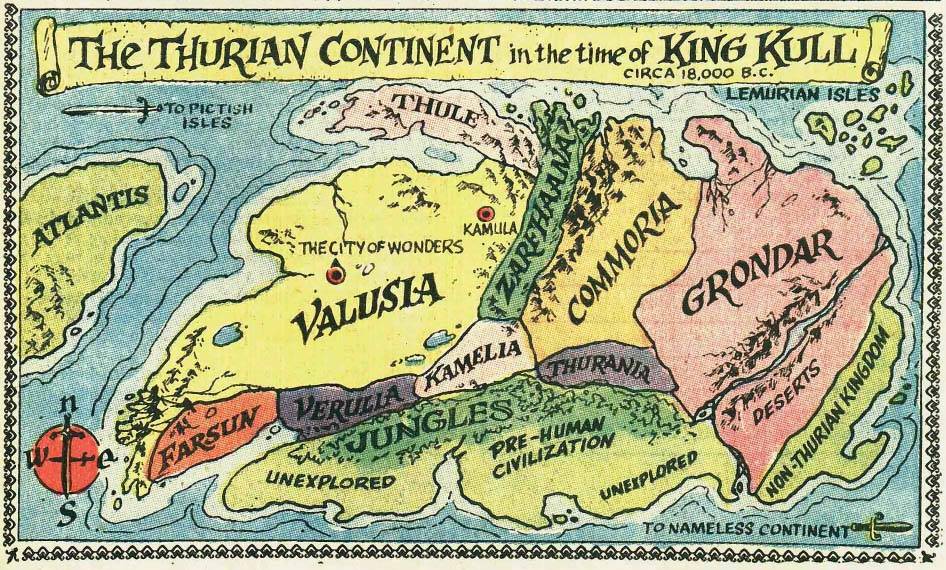
Valusia is the pinnacle of human civilisation in Kull’s time, even if it is fading into decadence. Grondar, the most easterly of the seven kingdoms, is home to a comparatively unsophisticated culture who eschew cities and frequently raid their neighbours. Almost nothing is known about the other Thurian kingdoms, which include Commora, Farsun, and Thule.
Some decades or centuries after Kull’s rule in Valusia, another cataclysm strikes the Earth. Atlantis and Lemuria sink, while the Pictish Islands rise to become mountains of a new continent. Thuria is severely affected as well, and the remains of the seven kingdoms disintegrate completely. The Thurian Age fades as human society collapses back to the paleolithic, but some of the remnant populations will go on to rise again as humanity begins to pull itself back together.
The Hyborian Age
In the millennia following the Cataclysm, humanity withers into savagery of different forms. The first people to begin to rise up from bestiality are the Hyborians, a tribal society of hunters who are spread across the north of the continent that was once Thuria. They are tall and strong, with light hair and grey eyes, and they slowly grow to sufficient numbers to expand out southwards into the continent.
As they spread, the Hyborians replace or absorb other, smaller tribes. They clash with the Picts, who are still ferocious, and the strange Stygians, a society founded after survivors from Lemuria encountered – and paid worship to – the remnants of an elder race. Other descendants of Atlantian and Lemurian survivors exist, mostly as bestial half-men. One of the more northerly tribes of Hyborians stumbles across the idea of stone buildings, and with their new, near-impregnable defences, quickly comes to dominate their neighbours. This becomes the kingdom of Hyperborea, the first settled civilisation since the Cataclysm.

In the centuries that follow, the Hyborians and their neighbours intermingle and settle, and the kingdoms of Conan’s time come into being. The greatest of all nations, the heart of the Hyborian Age, is Aquilonia, a landlocked kingdom inspired by the Carolingian Empire and located where France and the south of England now lie. Its provinces provide archers, pike-men and mounted knights, and it is considered the dominant military and commercial power. It has a temperate climate and plenty of fertile soil, supporting almost six million people. The capital city, Tarantia, is home to hundreds of thousands. Conan finally comes to rule Aquilonia after gaining power in its Westermarck region – the rough north-western frontier of the country that borders on the Pictlands.
The Pictish Wilderness that spreads out from the Westermarck, past the Black River, is a savage, cheerless place home to the scattered Pictish tribes, inspired somewhat by pre-revolution tales of Native American peoples. The land is beneath the seas now, but it lay past Ireland and Scotland. In the Hyborian Age, it is a coastal plainland of tangled forests, with occasional stretches of marsh or open glade. Many dangerous creatures hunt those forests, including bears, wolves, sabre-toothed tigers, venomous snakes, and even dragons, but none are deadlier than the stubborn, savage Picts themselves, who have survived down from before the Thurian Age without being much affected. Pictland has a huge ocean border, more than twelve hundred miles, but the Sea-Land Picts are little more than debased beach-combers, dwelling in tiny villages and scavenging for carcasses, including ivory for trade.
The British Isles are what remains of it after millennia of erosion and inundation, and it draws heavily on Howard’s imagined version of the Celtic peoples.
North of Aquilonia lies Cimmeria, the dour, craggy land of cold and mist that is Conan’s birthplace. The British Isles are what remains of it after millennia of erosion and inundation, and it draws heavily on Howard’s imagined version of the Celtic peoples. Cimmeria is a harsh land that breeds strength into its folk, who are a tall, strong breed with dark hair and grey or blue eyes. They are the last outpost of the survivors of Atlantis, risen again from the bestial barbarism they were plunged into after the Cataclysm. There is no central Cimmerian government, and no room in that bleak land for the corruptions of civilised society. Instead, they are a culture of hunter-gatherer clans who feud ceaselessly amongst themselves, and prize honour, strength of arms, and their stern code of justice. They are not ignorant savages – Conan’s father is a talented blacksmith, and Conan himself speaks many languages – but they are focussed on those elements of life that are the most practical for them. The constant fighting makes them fierce and resilient warriors, and their harsh environment leaves them skilled in tracking, climbing, and stalking. Conan is the most talented of his people of course, but the skills and virtues that he possesses are typical of Cimmerians as a whole.
The unhappy Border Kingdoms lie between Cimmeria and Nemedia, and stretch further north-east. Now they are the Baltic Sea, but even in the Hyborian Age, they are a marshy wilderness. There is no real law or order in the country, and although there is notionally a king, most of his population consists of bandits and savages. Sometimes merchants desperate enough to avoid Nemedian taxes use it as a dangerous route between Aquilonia and points east.
Aquilonia’s primary rival is Nemedia, on its mountainous eastern border. Inspired by Byzantium and the Holy Roman Empire, it roughly occupies modern Austria, Switzerland, northernmost Italy and southern Germany. It’s a highly cultured kingdom, with a long history of learning and scholarship, and a tradition of artistic endeavour. The heart of its military are the Nemedian Knights, clad in impressive metal armour, but the knights are bolstered by mercenary troops from the frozen north, the fierce, unruly Aesir of Asgard. The capital, Belverus, is in the west of the realm, and is famed for the fine quality of the jewellery and armour that it produces.
South-east of Aquilonia lies Ophir, a lovely kingdom of mountains and rivers, and beautiful cities. The capital, Ianthe, is a marvel of towers and domes, centred around the Citadel, where the king’s court, the Ianthium, is located. The country expands across most of modern northern Italy, as well as portions of what is now the Mediterranean. Ophir is not large, but it is rich in gold and gems, like its Old Testament namesake, and this wealth is worked into the armour of its knights. The mountains that form the Nemedian border are the main source of this wealth, and they are considered impregnable – the few passes that exist are infested with vampires and ghosts of various sorts. The only soft border it possesses is with Koth to the south, and Ophir pays yearly tribute rather than be invaded by their neighbour’s mad Emperor.
The kingdom of Argos is directly south of Aquilonia, and it is considered the dominant maritime power of the Hyborian Age. Like Ophir, it is another small country with wealth far greater than its size would suggest, with less than two million people. Its merchants and lords are known for the intrigues that they spin. Argos is based on medieval Venice and other Mediterranean ocean traders, and occupies a space that more or less spreads from southern France downwards and across the Mediterranean basin. Its important cities are all along the coast, including the capital, Messantia. Further inland, orchards and forests supply the dominant ship building industry with timber.
Zingara is the last of the seven nations on Aquilonia’s borders, and it is a nation consumed with its rivalry with Argos. The land border between Zingara and Argos consists of forests seething with ghouls and monsters, so their conflicts take place on the open sea. The kingdom is located over what is now the Iberian peninsula, and loosely inspired by the peoples of the same. Zingarans are proud people and clever sailors, second only to their rivals. They are also enthusiastic pirates. They would have more influence internationally, but constant infighting amongst the nobility weakens them as a power. The king rules in the capital of Kordava, which boasts one of the finest harbours of the Age, but his word carries little weight outside the city.

Past the nations that border Aquilonia, correspondences with modern geography become somewhat less certain. North of Cimmeria lie Vanaheim and Asgard, the frozen nations of Nordheim that were the cradle of the Hyborian peoples. It may be that Nordheim is what remains of the enigmatic pre-Cataclysm nation of Thule. In the modern era, the mountains of Asgard remain in the form of the Scandinavian peninsula, but Vanaheim is long-since drowned.
Vanaheim, the west half of Nordheim, is tundra, a bleak place that is inhospitable at best. The western coast is slightly less bleak, and the peoples there fish, hunt and scavenge. Further inland, life is harder, and there is little there for people short of fighting and hunting the scarce game. The Vanir are ferocious warriors, bloodthirsty and harsh, and the nation comprises many tiny chiefdoms and kingdoms.
To the east, Asgard, home of the Aesir, has mountains and forests but no coast. This means they have a significantly larger supply of game to hunt than their neighbours, and they are slightly less vicious and hostile as a result. Like the Vanir, the Aesir live in tribal kingdoms, each one ruled from the king’s great hall, and they survive by hunting, trading meat and ivory, and raiding each other. There is just one clear visible difference between the Vanir and the Aesir – the former are red-haired, the latter blonde. Otherwise, they are similarly tall, pale, muscular peoples, fur-clad and horn-helmeted, and to be greatly feared in battle.
To the East of Nordheim lies Hyperborea, an ancient, haunted land of grim stone fortresses spread across endless snowy plains. It is analogous with modern Finland and the north-west corner of Russia. The Hyperboreans are extremely tall, gaunt, and pale, with white hair and green eyes. They are ruled by a witch-queen, who vests her authority in a guild of wizards called the White Hand. Whilst the land they live in is forlorn, their sorcerous power is immense, and their culture is steeped in the arcane and unhallowed. The Hyperboreans are endlessly hungry for slaves, and although they retain a particular spite for Aquilonia, they are feared by all wise nations.
Below Hyperborea, and bordering Nemedia, is Brythunia, which would eventually become the Baltic States. It is a flat country, a place of prairies, plains, and forests, and horses are a vital part of everyday life its peoples. There are some fortified cities ruled over by this or that member of the country’s nobility, but for most of the Brythunians, life is rural, or even nomadic. They are known as a spirited, attractive people. The king of the country has little influence outside his capital of Pirogia, but he and his lords can field a huge, frighteningly well-disciplined cavalry in time of need.
Corinthia lies south of Brythunia and Nemedia, below the Karpash mountains. Inspired by ancient Greece, it is a confederacy of mountainous city-states known for its impressive weaponry and lethally efficient infantry shield-phalanxes. Although there is a king, each city is truly ruled by its senator and attendant council. The Corinthians are a primarily agricultural people, although there is some limited mining and trade from caravans passing east. It is one of the few nations of the Age that is actually friendly towards Aquilonia.
East of Corinthia is Zamora, a wizard-infested nation ruled despotically by a puppet king wholly in thrall to his sorcerous chief advisor. The people of Zamora worship Zath the Spider-God, and the country is famed for its tall, spider-infested towers raised in his honour. Zamora is steeped in arcane mystery and intrigue, and its wizards can see far indeed. It also maintains a vast network of spies and assassins across the rest of the nations. It is these disturbing agents, more than the nation’s modest army, which keep it safe from invasion.
The empire of Koth nestles south of Ophir, Corinthia and Zamora. Once, it was the heart of the great empire of Acheron, a pre-Hyborian state that is thought to have once been home to refugees fleeing the fall of Valusia and its snake-people masters during the Cataclysm. A large country, it includes mountains, prairies, fertile plains, an escarpment, and even an extensive desert. Although it is one of the most powerful nations of the southern Hyborian lands, and several other states pay it tribute, its emperor is insane, and his whims have driven the once-mighty country into poverty.
Shem lies to the south-east of Argos and to the south of Koth. Inspired by the great Mesopotamiam civilisations, it is an ancient, sprawling land with mines of copper and gold, and land well-suited to vineyards, fruit, and cattle. Sprawling as it does between the lunacy of Koth and the malignancy of Stygia, it is a land of fierce, intelligent people well-practiced in resilience and adaptation. Shemite textiles, crafts, and devices are as highly sought-after as the nation’s gold and wines.
Below Shem, across the river Styx, Stygia is the evil that lurks between the Hyborian nations and the far south. When Valusia fell, refugees came here, and some of their serpent masters came with them. It is said that the serpent people still abide here, in hidden places, spreading their unhallowed knowledge and advancing their plans. Certainly the ruling theocracy is open in their worship of Set, the Serpent-God. Much of Stygia is desert, but those sands are home to innumerable ruined temples, arcane tombs, and ancient wizards’ towers. There are some marshes and forests along the coast in the west, and a bit of rainforest in the south, but the desert, and the things it hides, are inescapable. No nation, not even Hyperborea, can match Stygia’s knowledge of sorcery and dark magics.
Further out, as you move beyond the sphere of Hyborian influence, knowledge gives way to rumour and legend. Heading south of Stygia, Kush is said to be the most civilised of the kingdoms that will become sub-Saharan Africa, but neighbouring Darfar and Keshan are savage and politically weak, and often raided by Stygian slavers. Punt is said to be rich in gold, but its neighbour, Zembabwei, supposedly mounts soldiers on huge, flying reptiles that are surely kin to dragons. Of the Black Kingdoms of the far south, little is even whispered, but the foremost amongst them is said to be Amazonia, a society of terrifying warrior women.
Moving east from Shem, over the wastes, you encounter Turan, the rulers of the huge inland sea, the Vilayet. They are expert horse-riders, and sweep the wastes incessantly, but they are always bedevilled by pirates and raiders. Iranistan is said to be a stony land with temperate coasts and demon-haunted mountains in its Drujistan region. Across the Vilayet sea from Turan is Hyrkania, whose wild, fierce horsemen are constantly fighting. Vast mountains keep these savage people away from Kosala and Vendhya, a pair of ancient and exotic allied kingdoms with access to strange mystic sorceries unknown elsewhere. The legendary land of Uttara Kuru is said to be near them, steeped in magic and strange practice.
The undisputed master of the far east is Khitai, ancient and powerful and vast beyond measure. Its wizards are said to be beyond compare. Rumours say that Khitai’s armies are endless, its God-Emperor wise and stern, and its might absolute. Despite this, Kambuja is its dire enemy, an equally ancient nation of jungles and strange temple-cities that fields its own terrifying wizards in battle, along with unstoppable war elephants. Kusan, a civilised and learned nation, supposedly keeps these voracious neighbours at bay through its superb cadre of diplomats and ambassadors. Only the most well-learned have any idea that in the oceans past Khitai, the remnants of archaic Lemuria still wait.
The fall
Five hundred years after Conan, the Hyborian Age collapses, weakened by constant barbarian assault and finally destroyed by invaders from Hyrkania. The root cause lies at Aquilonia’s feet, however.
Having annexed Zingara, Argos, Ophir and parts of Shem, Aquilonia forces tribute out of Koth, Corinthia, and those parts of Shem it had not simply absorbed. Other powers rise against them, and Aquilonia is forced into a series of battles from all directions. While they are distracted, aided by a zealous Nemedian reformer, the Picts swell mightily in both number and technological understanding, and become a constant and sophisticated threat.
During a war with Nemedia, Aquilonia is betrayed by the long-mistreated people of its western Bossonian border district, who allow a Pictish raider host to flood through unopposed. Distracted, Aquilonia lose to Nemedia, then respond savagely against the Picts. The brutality of the retaliation unites the Picts into a full invasion, which sweeps down through the decadent Hyborian nations like fire. The Cimmerians flooded from the north to take part in the slaughter and plunder. With Aquilonia in tatters, no nation can resist. As the Aquilonian Empire disintegrates, the Hyrkanians in the east sense weakness and attack, coming through Zamora in a tide of blood. Eventually, the Picts and the Hyrkanians fight each other to a standstill either side of Nemedia – the last remnant of the age of Hyborian civilisation.
The Nemedians abide, for a time, as do the Cimmerians. But the advancing glaciers grind everything to dust, driving humanity before them in a savage, squalling mess of barbarism. The final blow to the Age is one last great upheaval, perhaps caused by glacial weight. Whole regions are drowned as Western Africa rises from the sea, and the Mediterranean floods in to cover what had once been Argos and Zingara and Ophir.
The continent that had once been called Thuria is forever shattered into pieces.
Look for the next installment in the Life and Times of Robert E. Howard series in a couple of weeks.

Tim Dedopulos
Tim is an author, publisher, and game designer with tons of experience. He’s writing the Life and Times of Robert E. Howard series for Conan.com.



